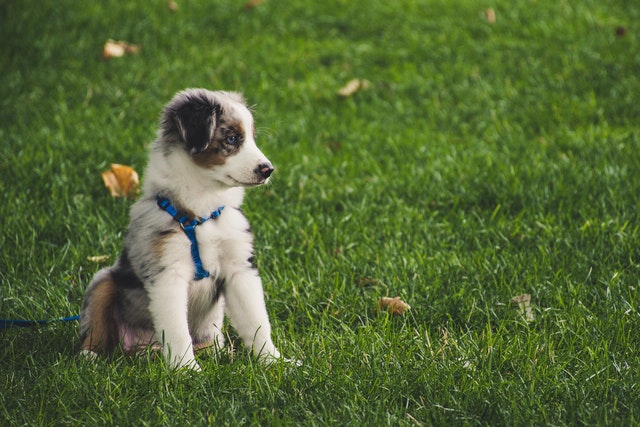

When Can I Take My Puppy for a Walk?
You probably can’t wait to take your new puppy for their first walk and see how they react to the big world – and let’s be honest, show them off! take a moment to make sure you understand your puppy’s limitations emotionally and physically.

Writer Animalia Team
7 min read

There’s nothing more exciting than bringing a new puppy home for the first time. You probably can’t wait to take them for their first walk and see how they react to the big world – and let’s be honest, show them off! But before you click your brand-new leash to your puppy’s brand-new harness, take a moment to make sure you understand your puppy’s limitations, emotionally and physically.
Creating a safe environment
Puppies need to be protected with vaccinations before it is safe for them to interact with other dogs or go places that other dogs (or sometimes other animals) have been. This is going to vary based on where you live and you should always follow your veterinarian’s advice. If you live in a busy city, most veterinarians prefer your dog to be fully vaccinated before they spend much time outside on the ground. If you live in the country, these expectations are a bit laxer. If you have a backyard that you can be certain no other dogs or stray animals are wandering into, you have a lot more ability to have your new puppy outside.
Always make sure your puppy, though, is supervised when outside. You should pay attention to temperature – keep it quick if it’s too hot or too cold and do not keep your pet outside for too long. Check out their reaction too – you do not want to overstimulate them and create a fear of the outdoors.
Familiarizing them with a safe and controlled outdoor environment allows them to build up confidence as they experience their new surroundings. This will be a great first step in raising a dog who is confident walking outside on a leash with all kinds of simulations, distractions, and potential scary objects or people.
Balancing health and well-being
So how do we balance keeping our new puppy safe from diseases while still encouraging their mental and emotional development? It is a very tough question. You could probably ask 100 different professionals and get 100 different answers but the truth is, the answer is going to be specific to your dog, your lifestyle, and your living situation. It is important to find a trainer and veterinarian who are willing to work together to figure out the best plan to set your pup up for the most success in life.
If you are unable to bring your unvaccinated puppy out for whatever reason, you can keep them mentally stimulated in the home by playing games like fetch and tug of war, and of course, keep them entertained by introducing them to simple commands such as ‘sit” and “stay”. You can also begin getting them used to their walking equipment by taking little “walks” around your living area. Slowly introduce your pup to their harness and leash and spend time walking them around inside as though you were out on a regular walk. This will help them greatly when you make the transition to being outside as it is one less new stimulus to deal with.

Going out to public places
You can also take them to public places at this point but always carry them in your arms and don’t put them on the floor. Hold them tightly but gently as they’ll almost definitely try to wiggle their way out when they see other dogs or people. It is important to not overstimulate or exhaust your puppy when taking them out. While it is exciting for you to show off your new puppy remember that they need 18 – 20 hours a day of sleep and even just a few minutes of high stimulation such as being in a new place, meeting a new person, meeting a new dog, or all three at once can be extremely exhausting for your new pup. Keep outdoor excursions to a set time limit that you feel your puppy is able to handle and do not be afraid to nicely ask someone who wants to fawn over your new puppy to please let them be.
Wait until they’re vaccinated
It is extremely important to wait until your vet has given you the okay to take your puppy for normal walks. There are many fatal diseases such as parvo, distemper, rabies, and leptospirosis that an unvaccinated puppy can get from being out on the street. Even if they are interacting with a dog that is fully vaccinated, they can still catch a number of diseases. The vaccinations protect the dog that has them but does not stop the vaccinated dog from being a carrier and infecting other unvaccinated pets.
Puppies typically receive their first vaccination at 8-10 weeks with the second dose being given two to four weeks later and a third dose being given another two to four weeks after that. On average, most puppies will be fully vaccinated at around 14-16 weeks but this does vary. What age you got your puppy and if they have had any past vaccinations will play a part. As in some cases will breed – many vets recommend that dogs who carry the black/tan gene get a fourth vaccination against distemper because they are more prone to getting the disease. If your vet wants you to wait until your pup is fully vaccinated before taking them out this typically means at least a week to two weeks after their final puppy vaccination.
How much exercise does a puppy need
While puppies do need exercise, you want to be careful not to tire them out too much. A tired puppy can be more irritable and not be as capable of making good decisions which can lead to unintended negative experiences in this young dog’s life. The amount of exercise a dog can manage will vary between breeds and dogs, so spend time with your dog and watch their behavior. When they seem tired, lagging behind or walking slowly, tongue out panting, not their normal puppy self – you have likely passed the threshold of how much exercise they need. Listen well to what your puppy is telling you, especially because their exercise needs will quickly change as they grow.
A good rule of thumb is to take your puppy’s age in months and then multiply it by five to work out how many minutes your puppy can walk in each session. For example, some 5-month-old puppies can be walked for 25 minutes, twice a day, while some 8 -month-old puppies can be walked for 40 minutes, twice a day. As they become older, they’ll be able to cope with larger amounts of exercise. It is important to take into account other important factors like the size, breed, and temperament of your puppy.
The health risks
Some types of exercise can increase your puppy’s risk of developing certain joint problems. Here are some tips to help reduce this risk:
- Avoid high impact exercise, such as jumping from heights
- Avoid sharp sudden turns, such as chasing a ball.
- Don’t throw sticks at them as they can splinter, wound or impale a dog when picked up in their mouth.
- Avoid using the stairs until at least 12 weeks old, but this may be longer for some larger breeds or breeds prone to back issues such as Dachshunds or Corgis.
- Make sure they stay at a healthy weight, as overweight puppies have an increased risk of joint disease.
- Never exercise your puppy on a full stomach, as this can contribute to a life-threatening health issue known as bloat.
If in doubt, your veterinarian will also be able to offer support and advice about the best ways to exercise your puppy.





We offer the most
comprehensive coverage
out there
car with a spare tire for life’s bumps.
Having Animalia is like a pimped-out
Rolls Royce with a swimming pool
in the trunk.



Get your pet insurance quote
Pet type
- Dog
- Cat
What is your pet's name?
Zip code





